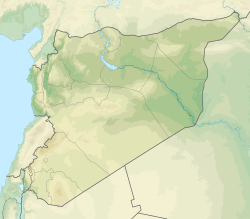Top Qs
Timeline
Chat
Perspective
Dead Cities
Group of abandoned settlements in northwest Syria From Wikipedia, the free encyclopedia
Remove ads
The Dead Cities (Arabic: المدن الميتة) or Forgotten Cities (Arabic: المدن المنسية) are a group of 700 abandoned settlements in northwest Syria between Aleppo and Idlib. Around 40 villages grouped in eight archaeological parks situated in north-western Syria provide an insight into rural life in Late Antiquity and during the Byzantine period. Most of the villages, which date from the 1st to 7th centuries, were abandoned between the 8th and 10th centuries. The settlements feature the well-preserved architectural remains of buildings such as dwellings, pagan temples, churches, cisterns and bathhouses. Important dead cities include the Church of Saint Simeon Stylites, Dahis, Serjilla, Ruweiha and al Bara.
The Dead Cities are situated in an elevated area of limestone known as Limestone Massif. These ancient settlements cover an area 20–40 km (12–25 mi) wide and some 140 km (87 mi) long.[1] The Massif includes three groups of highlands: the first is the northern group of Mount Simeon and Mount Kurd; the second middle group is the group of Harim Mountains; the third southern group is the group of Zawiya Mountain.
Remove ads
History
Summarize
Perspective

Chris Wickham, in the authoritative survey of the post-Roman world, "Framing the Early Middle Ages" (2006) argues that these were settlements of prosperous peasants which have few or no specifically urban features. The impressive remains of domestic architecture are the result of the prosperity of peasants who benefited from a strong international trade in olive oil at the end of Antiquity.
Another argument is that these were prosperous cities that flourished because they were located along major trade routes in the Byzantine Empire, and not merely prosperous peasant settlements. After conquest by the Arabs, the trade routes changed, and as a result, these towns lost the majority of the business which fostered their economies. On this view, settlers eventually abandoned their towns and headed for other cities that were flourishing under the Arabs and the Umayyads as increasing urbanisation took its toll.
The ancient villages of the Dead Cities illustrate the transition from the ancient pagan world of the Roman Empire to Byzantine Christianity.
The Dead Cites were inscribed as a UNESCO World Heritage Site in 2011, under the name of "Ancient Villages of Northern Syria".[2] The Dead Cities were the 1348th site to be added to UNESCO's World Heritage Site list. The Dead Cities have been on the Endangered UNESCO list since 2013, meaning the site was not endangered for only two years.
Before the Syrian Civil War most sites had become easily accessible, the majority of the dead cities were well-preserved and tourists could access the sites quite freely, though some of the Dead Cities are quite difficult to reach without a guide (there is a guidebook by Abdallah Hadjar with a detailed map that is useful for finding the lesser known sites; The Church of St Simeon Stylites and Other Archaeological Sites in the Mountains of Simeon and Halaqa. However, the Syrian Civil War has caused Syrian refugees to flee to these sites in hopes of finding shelter.[3] In various areas, refugees have repurposed the stone ruins located on these sites to rebuild their livelihoods.[4]
Remove ads
Archeological sites
Summarize
Perspective
Dead cities and archeological sites in Limestone Massif include Church of Saint Simeon Stylites, Serjilla, Bara, Basufan, Barisha, Qalb Loze, Barad, Cyrrhus, Turmanin, Banabil, Kafr Aruq, Kafr Dariyan, Babuline, Hazarin, Jarada, Maghara, Shinan, Farkya, Ein Laruz, Ebla, Deir Sunbul, Al-Dana, Sarmada and Al-Dana.[5][6]
Mount Simeon, Mount Kurd and Mount Ḥalqa
Harim Mountains (Mount Bārīshā and Mount A'lā)
Mount Zāwiya
Remove ads
See also
References
External links
Wikiwand - on
Seamless Wikipedia browsing. On steroids.
Remove ads





























































